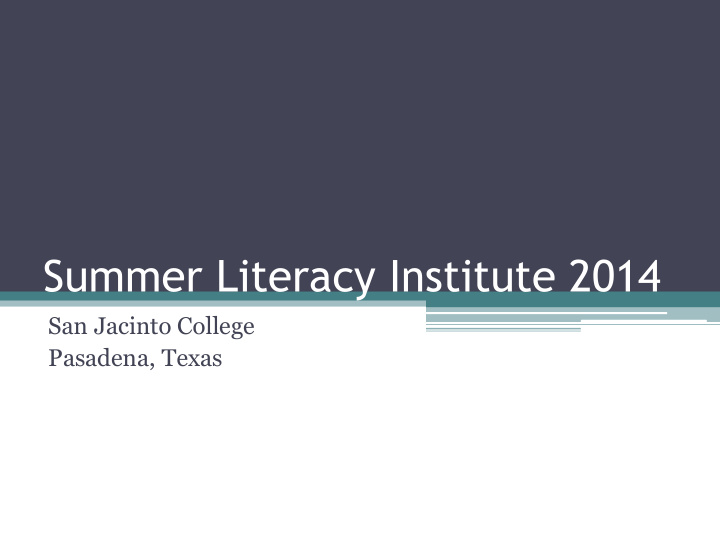



Summer Literacy Institute 2014 San Jacinto College Pasadena, Texas
Critical Thinking: A Thread Woven Karen F. Boyce College Preparatory and ESOL Dept.
Critical Thinking: A Thread Woven...
Throughout the Fabric of the Course Critical Thinking is the conscious processing of information at different levels of complexity. • Students must be given explicit instruction and guided practice in critical thinking from the beginning to the end of the semester. • There are many models on which to base instruction:
• Bloom’s Revised Taxonomy (pyramid)
• Bloom’s Bakery (layer cake)
• Kathy Schrock’s “ Bloomin ’ Apps” (gears)
Metacognition • The key to unlocking critical thinking is self- awareness . • Students need to be shown how to listen to their own thoughts and purposefully focus them at different levels of complexity. • Students must also be shown ways to record their thoughts and use them to construct appropriate responses to academic tasks.
A Place for Everything... (classification) Students develop an interactive notebook divided into sections (3-ring binder required). • Class notes • Reading/Writing Assignments • Vocabulary list • Journal • Portfolio
What’s in a Word? Students complete a weekly vocabulary log.
Reading: A Complex Process Students need to understand that there is a sequence of steps that they should follow to maximize comprehension of academic texts. Annotation and note-taking are carried out concurrently with each step. • Pre-read • Skim • Reread (Deep Read)
Reading Comprehension Deep reading requires students to analyze a text with the objective of recognizing and articulating implicit aspects of that text: • author’s assertions, assumptions, biases, and position • generally held assumptions relating to a subject • students’ own assumptions
Annotation – “Not Just For Decoration” • Students explore and identify important parts of text. • Students insert their own comments and questions in and around text.
Annotation is a worthwhile I‘m going to * try this on investment of a student’s time. my next reading assignment. * investment = something on which you spend (time or money) in order to receive some benefit in return
Organizing Information The Cornell Notetaking System is an interactive model for arranging notes on a page.
Sample Cornell Notes Course: Student’s Name: Date: Topic: Prior information from previous experience, print, or Knowledge audio-visual sources) Keywords, definitions Key Ideas explanations/illustrations/examples Questions, unanswered questions arising from text Insights insights arising from text/connections to personal knowledge and experience; to previous print and audio-visual sources; to events in other places SUMMARY: main idea and major supporting points in the order they are presented in the reading (Do not include your personal opinions or evaluations of the author’s ideas.)
Assessment: Aligned to Levels of Complexity • Test Preparation: Study guide items are based on levels of complexity. • Exams: Exam items contain the same language as those on the study guide.
Sample Study Guide Item Persuasion • Remember the definition of argument : state orally or in writing the reasons that support a particular viewpoint.
Sample Test Item Persuasion • Write the definition of the word argument as it relates to persuasive writing. (remember)
Writing to Communicate Students need to understand that there is a sequence of steps that they should follow to communicate effectively in writing for academic purposes. • Planning, Organizing, and Drafting (prewriting form) • Revise (review Turnitin and/or Smartthinking feedback) • Edit • Proof
Sample Prewriting Form
Writing in Response to Reading • Students benefit from have stimulating input to prepare them for processing information from text. • Short video clips are a good resource for eliciting critical thinking in preparation for reading. • Encourage discussion and elaboration of responses.
Assessment: Reading Comprehension and Writing Skills Sample 1: • Based on the article (included in exam), what is the position of the CCFC, and what argument do they use to support that position? (Write complete sentences.)
Assessment (continued) Sample 2: • Based on the reading, what is the position of the Fisher-Price Company, and what argument do they use to support that position? (Write complete sentences.)
Assessment (continued) Sample 3 • Based on the reading, what is the author’s counterargument to the Fisher-Price argument? (Write complete sentences.)
Assessment (continued) Sample 4: Based on the reading, write a standard length persuasive paragraph that includes the following: • Include your position on this issue? • Support your argument citing information from the passage as well as other sources. • Make a specific recommendation to parents regarding the use of electronic devices and infants.
Assessment: Portfolio • Scope: all semester • Format: section of interactive notebook • Contents: table of contents, reading/writing self-assessment, checklist for each assignment, completed assignments
Portfolio: Reading/Writing Self-Assessment
Portfolio: Final Evaluation
Resources • Slide 3: cartoon http://www.cartoonstock.com/newscartoons/cartoonists/aba/lowres/education- teaching-critical_thinking-pre_pack-curriculum-teacher-new_job-aban1261l.jpg • Slide 4: woven fabric http://www.fabricandart.com/web_images/shot_silk_fabric/group.jpg • Slide 6: Bloom’s Taxonomy original and Revised (pyramid) http://ww2.odu.edu/educ/roverbau/Bloom/blooms_taxonomy.htm • Slide 7: Animated Interactive Bloom’s Taxonomy (layer cake) http://www.coe.uga.edu/epltt/images/bloom.swf • Slide 8: Bloom’s Taxonomy iPad App (gears) http://rebeccalucas.edublogs.org/files/2013/03/blooms_gears_ipad_720x952- 2cpl0pd.png
Recommend
More recommend